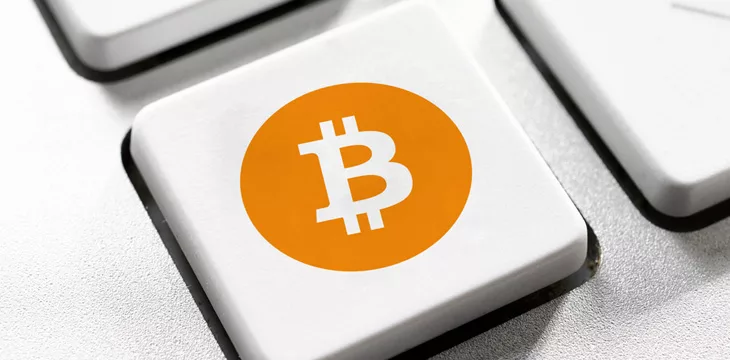|
Getting your Trinity Audio player ready...
|
This week’s ‘flash crash’ of the BTC token only serves to underscore the utter lack of utility behind this bastardized, function-free protocol.
In hindsight, it was inevitable. Jim Cramer, the CNBC financial analyst whose half-baked predictions are infamous for going sideways, took to the airwaves Tuesday to hail BTC’s “remarkable comeback” from its epic swoon following the onset of ‘crypto winter’ nearly two years ago.
In this latest episode of Cramer’s love/hate relationship with all things BTC, Cramer called the token “a technological marvel” that is “here to stay.” Digging himself deeper, Cramer said, “You can’t kill” BTC. Well, you might not be able to ‘kill’ BTC, but you can pluck its wings off like a demonic toddler and watch the wounded creature flail helplessly.
Not long after Cramer’s pronouncement, BTC’s value tanked 9% from its $45,400 fiat valuation—a height not seen since March 2022—to below $41,000, all within a couple of hours. At the time of writing, the token has only partially recovered from this tumble, and it’s anyone’s guess when the rollercoaster might again go off its rails.
Cramer’s latest flip-flop notwithstanding, much of the blame for the air going out of BTC’s balloon was directed at Matrixport analyst Markus Thielen, who issued a report on Tuesday claiming that the U.S. Securities and Exchange Commission (SEC) planned to “reject all proposals” for BTC spot-based exchange traded funds (ETF) this month.
Anticipation that the SEC is poised to approve a dozen or more BTC ETFs next week has been credited with much of the token’s fiat gains over the past month or so. Until a court order this summer, the SEC had previously rejected all BTC ETF applications, citing the ease with which BTC’s price could be manipulated by wash trading on digital asset exchanges like Binance using the Tether (USDT) stablecoin.
Matrixport expected the SEC to reject the current crop of applications because all of them “fall short of a critical requirement that must be met before the SEC approves.” The report claims that SEC chairman Gary Gensler believes that the digital asset sector is “in need of more stringent compliance.”
Matrixport noted the extra billions of fiat dollars that have entered the sector in anticipation of ETF approval and so “any denial by the SEC” could result in “cascading liquidations” of perpetually long BTC futures positions. The net result would drag BTC’s fiat value down by 20% “very quickly.”
While the market appears to have been seriously spooked by this report, it regained some of its lost ground after Fox Business reporter Eleanor Terrett tweeted that the SEC was “holding meetings today with the exchanges (@Nasdaq, @CBOE, @NYSE) to finalize comments on the 19b-4s submitted by the $BTC Spot ETF issuers.”
Gensler’s next moves may be unpredictable, but the idea that BTC’s fiat price is forever hinged on rumors, conjecture, and hearsay is (sadly) all too predictable. As is the fact that analysts covering this market have a tendency to take both sides of the coin, whether to hedge their bets or achieve more manipulative goals.
For instance, just one day before its ‘SEC will deny’ report, Matrixport released a different report claiming that ETF approval was “imminent” and would cause BTC to “jump to $50,000.” To paraphrase Johnny Rotten, do you ever get the feeling you’ve been manipulated?
Pick me! PICK ME!
ETF applicants have indeed been furiously amending their documents, including naming the entities that will serve as authorized participants, i.e., the SEC-approved businesses responsible for moving cash in and out of ETFs. For instance, Wall Street giant Goldman Sachs is reportedly discussing the possibility of serving as an authorized participant for ETFs proposed by BlackRock (NASDAQ: BLK) and Grayscale Investments.
January 10 is the deadline for the SEC to decide whether or not to approve the ETF application by 21 Shares and Cathie Wood’s ARK Investments, but the SEC could theoretically start announcing approvals as early as January 4. Should Wood be in for some good news, the SEC will likely announce the approval of other pending applications simultaneously so as not to give any one ETF a ‘first-mover’ advantage over its rivals.
Assuming most or all of the 14-odd applicants are approved in short order, whatever cash may be waiting to invest in ETFs will be divided among them, leaving none of them looking like horses bolting out of the gate. And as we’ve seen, in Cryptoville, perception is often more important than reality.
Some applicants are already trying to game this perception issue by undercutting the others on management fees. Fidelity has reportedly set its annual fee at a mere 0.39%, while the Invesco Galaxy ETF plans to waive its fee entirely for the first six months on the first $5 billion in total assets. Not enough? What if we throw in a free set of steak knives?
ETF or WTF?
More cautious observers have been trying to dampen expectations that ETF approval will light a fire under BTC, warning that approval might already be ‘baked in’ to BTC’s current price, and, thus, the approvals will be a ‘sell the news’ event. But these voices are largely drowned out by the self-interested cheerleading that BTC’s only true course is due north, making every ‘correction’ an easily dismissed and temporary deviation from the norm.
The belief that spot-based ETFs will unleash a torrent of new money into BTC is partly due to the historical interest in similar products based on more tangible elements, such as gold. Gold-based ETFs have been around for decades, but there are important distinctions to be made between these ETFs and one based on BTC. For instance, moving gold around is physically cumbersome, whereas BTC has always existed in digital form, making the ETF angle far less of a game-changer.
U.S.-based individuals interested in acquiring BTC or other tokens can already do so simply via registering for a U.S.-based digital asset exchange. They can even acquire BTC via their existing accounts on more mainstream fintech platforms such as Robinhood. Assuming they’re willing to let others custody their tokens—much like how an ETF works—no digital wallet expertise is required. So, the idea that an ETF will suddenly unleash the fiat floodgates for the tech-phobic masses is hardly a sure thing.
The expectation that ETF approvals are a sure thing also ignores the fact that the concerns cited by the regulator in its previous denials—particularly the market manipulation issue—have in no way been resolved to anyone’s satisfaction. As such, the exuberance that led to BTC’s recent value bubble may prove all too irrational. But hey, given BTC’s history, why stop now?
Utility trumps all
It is highly comedic—at least, in the tragicomic sense—that this latest caterwauling over ETF approval came on the 15th anniversary of the creation of Bitcoin’s Genesis block. Many of the same individuals who boldly (and incorrectly) declared that Bitcoin was a weapon of mass destruction for the established tradfi giants are now on their knees pleading for those same Wall Street titans to rescue them from serfdom.
While Bitcoin was originally modeled as peer-to-peer electronic cash, the controversial changes to the protocol that created BTC left the latter effectively useless as cash due to its high fees, which is why no one uses BTC as anything other than a casino chip.
Worse, the artificial constraints put on BTC by the Bitcoin Core developers were intended to achieve this uneconomic dilemma. The idea was to force users onto proprietary Layer 2’s such as the Lightning Network, where fees may be lower, but design flaws mean all transactions involve shutting one’s eyes, spinning the big wheel, and wishing upon a star (and/or asking AI to solve the problem).
BTC’s flaws have left its proponents with only one option: promoting a ‘digital gold’ mantra that might encourage others down this dead end where they’ll serve as exit liquidity for the earlier fools. Worse, it’s sucking up all the media oxygen, crowding out more worthwhile projects.
On this anniversary of Bitcoin’s launch, do yourself a favor and investigate the BSV blockchain, where ‘number go up’ means fulfilling Satoshi Nakamoto’s original vision of a scalable blockchain capable of handling a near-infinite volume of transactions at fees measured in fractions of a cent. Technology you can actually use? Heresy!
Follow CoinGeek’s Crypto Crime Cartel series, which delves into the stream of groups—from BitMEX to Binance, Bitcoin.com, Blockstream, ShapeShift, Coinbase, Ripple, Ethereum,
FTX and Tether—who have co-opted the digital asset revolution and turned the industry into a minefield for naïve (and even experienced) players in the market.

 01-02-2026
01-02-2026 




